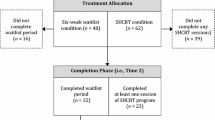Abstract
The present investigation focused on Gamblers Anonymous (GA) members in Ohio to ascertain whether or not spousal participation in Gam-Anon, the companion support group, decreased the gambler's relapse into gambling behavior. A cross-sectional survey of 43 GA members was conducted using a self-administered questionnaire. While no significant difference was found in the relapse of those gamblers with or without a spouse in Gam-Anon, the degree to which the gambler had engaged in other addictive-like behaviors in the past did appear to be related to relapse. Those gamblers who had not relapsed reported significantly more engagement in past addictive-like behaviors (excessive overeating, drinking, and using drugs) than those who had relapsed. Additionally, their spouses had also engaged in addictive-like behaviors in the past. Discussion suggests possible explanations for the findings. Implications are drawn for both outcome measures and research with self-help groups.
Similar content being viewed by others
References
American Psychiatric Association (1987).Diagnostic and statistical manual of mental disorders (3rd ed.). Washington, DC: Author.
Bailey, M. (1965). Al-Anon family groups as an aid to wives of alcoholics.Social Work, 10, 68–74.
Boyd, W.H. & Bolen, D.W. (1970). The compulsive gambler and spouse in group psychotherapy.International Journal of Group Psychotherapy, 20, 77–90.
Brown, R.I.F. (1986). Dropouts and continuers in Gamblers Anonymous: Life-context and other factors.Journal of Gambling Behavior, 2, 130–140.
Corenblum, B. (1983). Reactions to alcohol-related marital violence: Effects of one's own abuse experience and alcohol problems on causal attributions.Journal-of-Studies-on-alcohol, 44, 665–674.
Custer, R., & Milt, H. (1985).When luck runs out. New York: Warner Books, Inc.
Dickerson, M.G. & Weeks, D. (1979). Controlled gambling as a therapeutic technique for compulsive gamblers.Journal of Behavior Therapy and Experimental Psychiatry, 10, 139–141.
Edwards, D.W. (1982). Spouse participation in the treatment of alcoholism: Completion of treatment and recidivism.Social-Work-With-Groups, 5, 41–48.
Glaser, F.b. & Ogborne, A.C. (1982). Does A.A. really work?British Journal of Addiction, 77, 123–129.
Greenberg, D. & Rankin, H. (1982). Compulsive gamblers in treatment.British Journal of Psychiatry, 140, 364–366.
Heineman, M. (1987). A comparison: The treatment of wives of alcoholics with the treatment of wives of pathological gamblers.Journal of Gambling Behavior, 3, 27–40.
Hugick, L. (1989). Gambling on the rise: Lotteries lead the way. TheGallup Report. Report No. 285, June, 32–41.
Lesieur, H.R. & Blume, S.B. (1987). The South Oaks gambling screen (the SOGS): A new instrument for the identification of pathological gamblers.American Journal of Psychiatry, 144, 1184–1188.
Lorenz, V.C. & Yaffee, R.A. (1989). Pathological gamblers and their spouses: Problems in interaction.Journal of Gambling Behavior, 5, 113–126.
Lorenz, V.C. & Yaffee, R.A. (1988). Pathological gambling: Psychosomatic, emotional and marital difficulties as reported by the spouse.Journal of Gambling Behavior, 4, 13–26.
Lorenz, V.C. & Shuttlesworth, D.E. (1983). The impact of pathological gambling on the spouse of the gambler.Journal of Community Psychology, 11, 67–76.
McCrady, B.S., Noel, N.E., Abrahams, D.B., Stout, R.L. Nelson, H.F., & Hay, W.M. (1986). Comparative effectiveness of three types of spouse involvement in outpatient behavioral alcoholism treatment.Joumal-of-Studies-on-Alcohol, 47, 459–467.
Politzer, R.M., Morrow, J.S., & Leavey, S.B. (1985). Report on the cost-benefit/effectiveness of treatment at the Johns Hopkins Center for Pathological Gambling.Journal of Gambling Behavior, 1, 131–142.
Powell, T.J. (1987).Self-help organizations and professional practice. Silver Spring, MD: National Association of Social Workers.
Preston, F.W. & Smith, R.W. (1986). Compulsive drinking and gambling: Relabeling people of leisure.Free-Inquiry-in-Creative-Sociology, 14, 201–206.
Rankin, H. (1982). Control rather than abstinence as a goal in the treatment of excessive gambling.Behaviour Research and Therapy, 20, 185–187.
Russo, A.M. Taber, J.I., McCormick, R.A. & Ramirez, L.F. (1984). An outcome study of an inpatient treatment program for pathological gamblers.Hospital and Community Psychiatry, 35, 823–827.
Taber, J.I. McCormick, R.A., Russo, A.M., Adkins, B.J., & Ramirez, L.F. (1987). Follow-up of pathological gamblers after treatment.American Journal of Psychiatry, 144, 757–761.
Tepperman, J.H. (1985). The effectiveness of short-term group therapy upon pathological gambler and wife.Journal of Gambling Behavior, 1, 119–130.
Volberg, R.A. & Steadman, H.J. (1988). Refining prevalence estimates of pathological gambling.American Journal of Psychiatry, 145, 502–505.
Volberg, R.A. & Steadman, H.J. (1989). Prevalence estimates of pathological gambling in New Jersey and Maryland.American Journal of Psychiatry, 146, 1618–1619.
Walker, G. (1985). The brief therapy of a compulsive gambler.Journal of Family Therapy, 7, 1–8.
Wright, K.D. & Scott, T.B. (1978). The relationship of wives' treatment to the drinking status of alcoholics.Joumal-of-Studies-on-Alcohol, 39, 1577–1581.
Wright, K.D. (1975).Current drinking status of alcoholic men and the treatment received by the non-alcoholic wives. Ph.D. dissertation, University of North Dakota.
Author information
Authors and Affiliations
Rights and permissions
About this article
Cite this article
Zion, M.M., Tracy, E. & Abell, N. Examining the relationship between spousal involvement in Gam-Anon and relapse behaviors in pathological gamblers. J Gambling Stud 7, 117–131 (1991). https://doi.org/10.1007/BF01014527
Issue Date:
DOI: https://doi.org/10.1007/BF01014527




